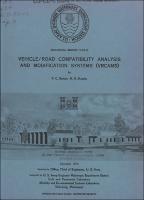Please use this identifier to cite or link to this item:
https://hdl.handle.net/11681/20607Full metadata record
| DC Field | Value | Language |
|---|---|---|
| dc.contributor | Mobility and Environmental Systems Laboratory (U.S.) | - |
| dc.contributor.author | Barber, Victor C. | - |
| dc.contributor.author | Murphy, N. R. (Newell R.) | - |
| dc.date.accessioned | 2017-01-11T18:50:36Z | - |
| dc.date.available | 2017-01-11T18:50:36Z | - |
| dc.date.issued | 1973-12 | - |
| dc.identifier.uri | http://hdl.handle.net/11681/20607 | - |
| dc.description | Technical Report | - |
| dc.description | Abstract: The prediction of quantities of men and materiel that can be moved and of the ability of tactical forces to advance across, withdraw from, or operate within the various land areas of the world has classically constituted an engineering problem of major proportion. The problem can be specifically defined as analysis of allied or enemy capabilities to utilize natural and man-made terrain features to their advantage and to modify that terrain as desirable for either their advantage or an opponent's disadvantage. Various staffs and study groups involved in such studies have recognized the need for analytical systems to treat all parameters affecting movement of ground vehicles. It is also generally recognized that current techniques can lead to development of improper information that creates the potential for erroneous or even catastrophic decisions. This technological environment has generated research in recent years to provide information and methodology required for accurate estimates. Pursuant to the Army Materiel Command (AMC) goal of cross-country mobility prediction for military vehicles, the WES, in its mobility and environmental oriented programs, has been involved in studies of the behavior of vehicles in a cross-country environment. Similarly, soils and pavements research programs, conducted by the WES under auspices of the OCE MEDECC program, as well as other programs, have been directed toward developing appropriate criteria and methodology for designing and evaluating roads and airfields. Both of these research groups have generated expertise that has been applied to the development of a comprehensive analysis system. The Vehicle/Road Compatibility Analysis and Modification System (VRCAMS) brings together the appropriate disciplines pertinent to vehicles, mobility, road geometrics, structures, and maintenance to determine and measure the compatibility of vehicle and its environment and the resultant product of movement. The system also treats the effects of constructive or destructive modification of vehicle and/or environment and the resultant impact on vehicle movement. The first-generation system, in computer code, serves to successfully combine all known parameters affecting vehicle movement, thereby taking total advantage of the st ate-of-the-art in related disciplines. Foreseeable and programmed improvements to the system imply significant advances in the state-of-the-arts of road deterioration analysis, vehicle reliability analysis, vehicle-road optimization, and overall allied material optimization. The VRCAMS consists of several subsystems that respectively treat mobility and ride dynamics, traffic volume, structural characteristics, maintenance, and vehicle movement. The parameters in each of the subsystems are brought together in a comprehensive manner to provide output data pertinent to vehicles moving on roads. Outputs provided by the VRCAMS include speed of given vehicles on specific road segments, traffic volumes that road segments can sustain at various levels of service, structural life of a specific road segment subj ected to known quantities of traffic, maintenance requirements to extend road segment life, and delivery rate and travel time for vehicles on road segments. Refinements and additions to the current model will provide for a greater degree of accuracy and for a broader range of applications such as road and vehicle design optimization, optimum use of roads and vehicles, and improved logistical and tactical planning. Research for FY 74 will consist of efforts to develop a road deterioration function, speed-deterioration relationships, and an applicability analysis for the VRCAMS. | - |
| dc.publisher | Soils and Pavements Laboratory (U.S.) | - |
| dc.publisher | Engineer Research and Development Center (U.S.) | - |
| dc.relation | http://acwc.sdp.sirsi.net/client/en_US/search/asset/1044647 | - |
| dc.rights | Approved for public release; distribution is unlimited. | - |
| dc.source | This Digital Resource was created from scans of the Print Resource | - |
| dc.subject | Military mobility | - |
| dc.subject | Military operations | - |
| dc.subject | Military roads | - |
| dc.subject | Military vehicles | - |
| dc.subject | Mobility terrain | - |
| dc.subject | Roads | - |
| dc.subject | Trafficability | - |
| dc.subject | VRCAMS | - |
| dc.title | Vehicle/Road Compatability Analysis and Modification Systems (VRCAMS) | - |
| dc.type | Report | en_US |
| Appears in Collections: | Technical Report | |
Files in This Item:
| File | Description | Size | Format | |
|---|---|---|---|---|
| TR-S-73-13.pdf | 9.78 MB | Adobe PDF |  View/Open |